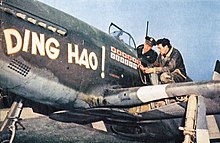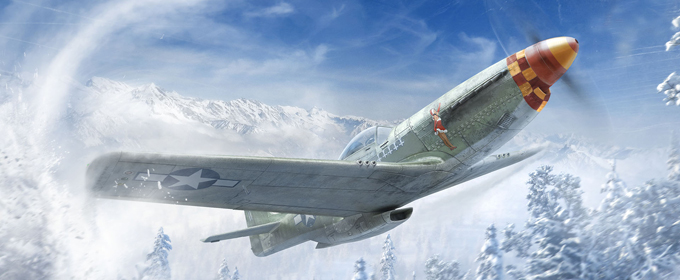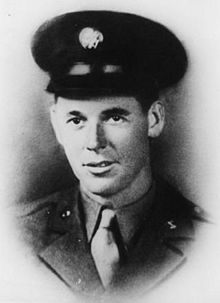1/11/1944 - Major James Howell Howard of St. Louis, Missouri (he is born in Canton, China where his ophthalmologist father is teaching eye surgery), a former Navy fighter pilot on the USS Enterprise, turned P-40 fighter ace as a member of the American Volunteer Group (the Flying Tigers), turned commander of the U.S. Army Air Force's 356th Fighter Squadron of P-51 Mustangs (based in Great Britain), leads a mission of fighters supporting B-17 Flying Fortress bombers attacking Oschersleben, Germany. Engaging enemy fighters assaulting the bomber stream, Howard shoots down a ME-110 (in his fighter, Ding Hao ... Chinese for "The Best"), but in doing so, loses contact with the rest of his group. Intent on his mission of protection, he pulls back up to the bomber group and finds it under attack by 30 or more Luftwaffe fighters ... and despite being alone, goes into an attack on the larger force. For about thirty minutes, Howard whips his Mustang through the German fighters, shooting down between three and six aircraft and damaging others ... and he continues to make attack runs even after his guns run out of ammo and he is dangerously low on fuel. As the leader of the bomber formation will state, "For sheer determination and guts, it was the greatest exhibition I've ever seen. It was a case of one lone American against what seemed to be the entire Luftwaffe. He was all over the wing, across it and around it. They can't give that boy a big enough award." For his actions, Howard becomes the only American fighter pilot to win the Congressional Medal of Honor in the European Theater of WWII.

Howard Having His Score Updated

Medal Of Honor Action

Howard
1/11/1945 - Finding his platoon under attack near Bastogne, Belgium, 26-year-old Staff Sergeant Archer T. Gammon of Chatham, Virginia, charges 30 yards through hip deep snow and takes out a German machine gun and its three-man crew with hand grenades. Opening the way for his men to advance towards a line of woods, Gammon goes into action again when riflemen, another German machine gun, and a Tiger Royal tank open up from the unit's left flank ... instead of hunkering down, under intense fire, the sergeant crosses the width of his platoon's skirmish line, and with grenades, takes out the machine gun and its four man crew. Not done, he then charges the tank, trying to get close enough to damage the giant with more grenades. Twenty-five yards away, Gammon's heroic day winning the Congressional Medal of Honor ends when he takes a direct hit from the backing away tank's 88mm gun ... his death not in vain, the craziness of the attack causes the German commander to retreat, opening the way for the sergeant's platoon to accomplish their mission, clearing the woods of Germans.

Gammon
Gammon On The Attack!
Remembered!
1/11/1945 - Two days after his first aerial victory, flying a F-6D Mustang designed for armed photo reconnaissance, along with his wingman, Lt. Paul Lipscomb, U.S. Army Captain William A. Shomo of Jeannette, Pennsylvania spots a large flight of Kawasaki Tony, Nakajima Tojo, and Mitsubishi Betty fighters and bombers heading south towards American targets, and instantly aborts his mission to photograph the Japanese bases at Tuguegarao, Aparri, and Laoag in the Philippines. Instead, pulling Immelman turns to position themselves behind the Japanese formation, the out numbered American pilots go on the attack, closing to within 40 yards before firing ... on his first pass, Shomo shoots down four Tonys, then fires into the belly of the Betty bomber, causing it to catch fire. Three Tony's escort the bomber as it goes down ... one turning back towards Shomo, firing until it stalls and disappears into a cloud ... as the Betty explodes. Bomber gone, Shomo then shoots down the two remaining Tonys ... seven victories in the space of just under six minutes of action (and while this is going on, Lipscomb tallies three kills of his own ... the other three planes in the original formation turn tail and flee), becoming an ace in a single day (only Navy Commander David McCampbell will have a better day, downing nine Japanese planes in October of 1944) and winning the Congressional Medal of Honor (along with being promoted to Major).

Shomo
1/11/1969 - Leading a 7-vehicle armored column to meet and escort a truck convoy along Vietnam's Highway 13, First Lt. Harold Arthur "Hal" Fritz (drafted while working towards a career in veterinary medicine) of Chicago, Illinois finds his unit suddenly ambushed by a reinforced enemy company. Surrounded and outnumbered, though seriously wounded, Fritz exposes himself to enemy fire, and goes from vehicle to vehicle, moving them into a defensive position (along with assisting the wounded, distributing ammo, directing fire on the attacking Vietnamese, and encouraging the surrounded men). Wagons circled as in a Hollywood western, Fritz breaks up one assault personally manning a machine gun, then when a second enemy force attacks, with only a pistol and bayonet, leads a small group of men in a daring charge which routs his opponents. Holding until relief arrives, Fritz risks his life again, guiding his rescuers into the best positions to keep the Vietnamese at bay, then assists his men in receiving medical attention, refusing to have his own wounds dealt with until all of his command has been treated and evacuated. For his valorous efforts near Quan Loi, Fritz is promoted to Captain ... and awarded the Congressional Medal of Honor.

Fritz

Award Ceremony
No comments:
Post a Comment